Most popular mobile messenger apps Worldwide 2020
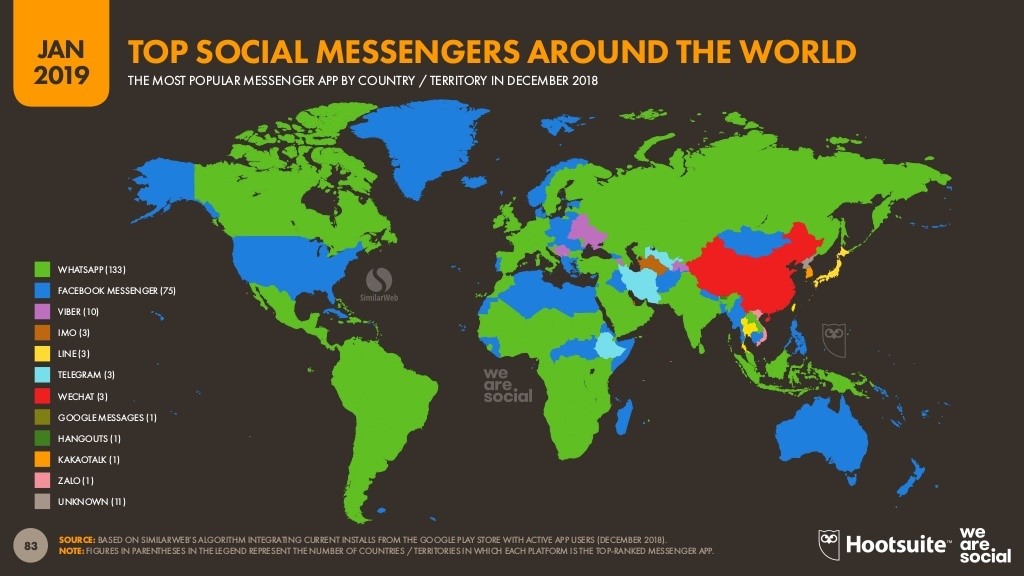
In this tech-savvy world, people prefer to send messages than talking over the phone. It is a quicker and comfortable form of communication. Posting messages on mobile apps are the new trend, and the trend becomes a reality due to the availability of many popular global mobile messenger apps. Many of the mobile messenger apps are the reason for the present-day texting changes, and some of them withered in the crowd, and new players started dominating the market.
Overview of Most popular mobile messenger apps Worldwide 2020
- 1 Most popular mobile messenger apps Worldwide 2020
- 2 Number of active users:
- 3 Number of mobile message users over the years:
- 4 Popular Messaging Apps and Key Statistics:
- 5 Growth trends:
- 6 Text instead of making a phone call
- 7 Time spent on messenger app:
- 8 Sessions of each app in use:
- 9 Reach of service provider among users:
- 10 Global leader:
- 11 Age group:
- 12 Gender basis:
- 13 In terms of revenue:
- 14 Top Social Messengers in the World (Hootsuite)
We shall analyze the current situation of most popular global mobile messenger apps with the help of available data. Messaging by using mobile messenger apps are instant, real-time chat. You can send messages using an internet connection. With the evolution of mobile phones into smartphones, the trend becomes part of our daily life.
You can find many free apps offering free texting and exchange of files and graphics. They are much cheaper as compared to the operator-based SMS service, and they save time too. The latest features allow people to add more than one person in the same conversation, and exchange of videos, audios and allowing people to create groups.
Number of active users:
Firstly, let us look at the number of active users per month for different service providers. Internet messaging apps give an option of sending graphics or even emoticons. So, there is a conversation even without really saying or writing anything. It is an exciting mode of interaction. Obviously, it is a preferred option than the routine boring simple messaging.
Monthly active users of mobile messenger apps as on October 2019
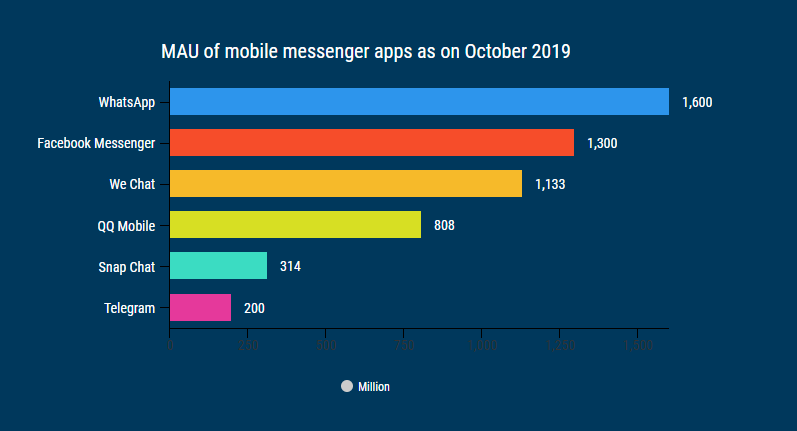
- In October 2019, about 1.6 billion users sent messages on WhatsApp. It is one of the maximum usages. (Statista)
- Facebook acquired WhatsApp in February 2014. (Statista)
- Facebook Messenger touched 1.3 billion marks. (Statista)
- We Chat also managed to cross the 1 billion mark with 1.133 billion users. (Statista)
- QQMobile had 808 million users and could not touch the1 billion marks. (Statista)
- The next position goes to Snap Chat, with 314 million users. (Statista)
- Telegram has 200 million active monthly users. (Statista)
Number of mobile message users over the years:
Let us study the systematic increase in the number of messaging service users over the years. The increased sales of smartphones are one of the reasons for the extensive use of the internet. Most of the basic smartphones also feature with online messaging apps. We can find a tremendous increase in the number of mobile app messenger users every year for messaging, and the projections for 2022 are overwhelming. (Statista)
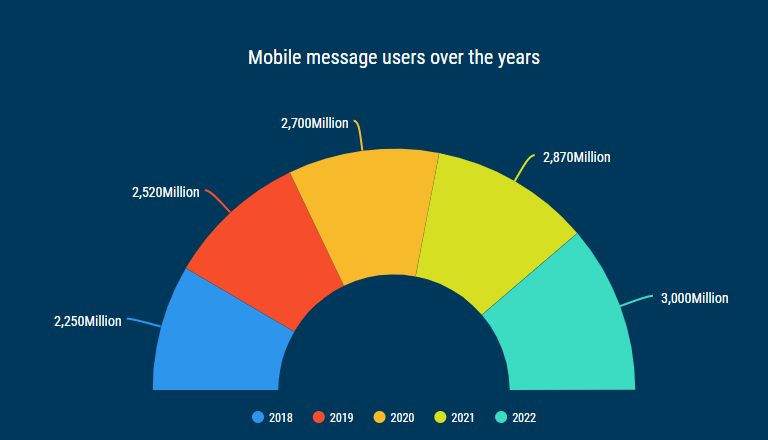
- Beginning in the year 2018, the number of worldwide mobile messaging service users were at 2.25 billion. (Statista)
- It rose to 2.52 billion the year thereafter in 2019. (Statista)
- The projection for 2020 is 2.7 billion. (Statista)
- By 2021, the figures expected to reach 2.87 billion users worldwide. (Statista)
- Considering the accelerated growth of world wide mobile message users, it will touch 3 billion in 2022. (Statista)
Popular Messaging Apps and Key Statistics:
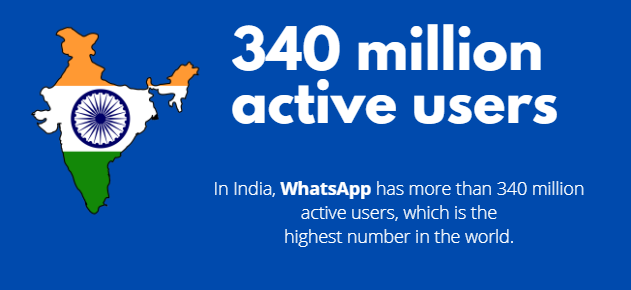
- In India, WhatsApp has more than 340 million active users, which is the highest number in the world. (99firms)
- About 90% of smartphone users have at least one mobile messaging app on their phone. (99firms)
- Companies prefer to communicate by using message apps. (99firms)
- In China, 98% of people use WeChat between the age of 50 to 80. (99firms)
- In the USA, teens predominantly use Snapchat. (99firms)
- People depend much on the messaging app to get the latest news updates than social media. (99firms)
- Voice chat is the second popular activity on messaging app after photo file sharing. (99firms)
Growth trends:
Even though the influx of social media is on the peak, there are still many who do not have a social media account, but they do use the online messaging app. The people who have smartphones use the online messaging service even if they do not use the camera much and are not active on social media. Some people do not like unnecessary attention and keep silent on social media. But they prefer sending personal messages using online message apps as they are fast. We can compare the growth of the messaging in a different term as below.
- In 2019 about 41 million messages were sent out in one minute by using mobile messaging apps. (Kommandotech)
- Messaging apps have 20% more users as compared to social media platforms. (Kommandotech)
- By the year 2020, the average revenue generation is expected to cross more than $15 per user by the online messaging app. (Kommandotech)
- The number of SMS used to send has been in the descending mode for the last few years. In 2011 the outgoing messages in the US were about 2.3 trillion. By 2016, the outgoing messages were only 1.6 trillion. (Kommandotech)
- The new-gen smartphone allows people to use multiple messaging platforms to send messages. Around 36% of people use two or more online service providers to post messages. (Kommandotech)
- In 2017 a survey showed that every 3 out of 4 smartphones have online messenger apps installed. (Kommandotech)
Text instead of making a phone call
Telemarketing has gradually faded out due to the influx of messaging features, which are quick and convenient. Unlike a phone call, you don’t have to attend the message immediately, and it gives you the freedom to read the message at your convenience and reply. Corporates depend much on mobile messaging apps, and the dominant player of the messaging market is Facebook, who owns and manages WhatsApp and Messenger, which has the largest market share in the world mobile message apps.
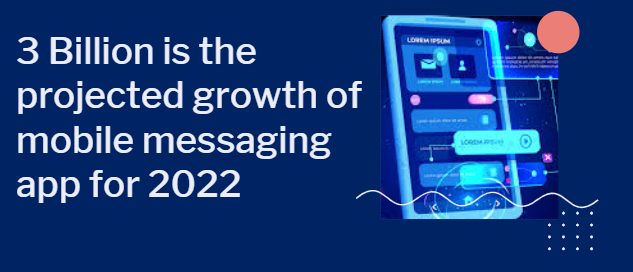
- 9 billion users are for WhatsApp and Messenger. (Kommandotech)
- 87 million people use Messenger in the USA. (Kommandotech)
- 52 billion people use mobile messaging apps. (Kommandotech)
- The projected growth of the mobile messaging app for 2022 is 3 billion. (Kommandotech)
- Except for 25 countries in the world, WhatsApp is the market leader in the messaging app. (Kommandotech)
Time spent on messenger app:
The more a user spends time on the platform, the more they are going to get used to it and engage with it. Users get more and more comfortable and start to use emoticons and also involve groups to make the conversation fun. Having a conversation with many people can be cool and for the professionals, it has significant advantages. They do not have to send instructions multiple times, and the works get executed quickly. Also, as for the family groups, good news, or any other information can share immediately with all the members rather than calling each of them individually.
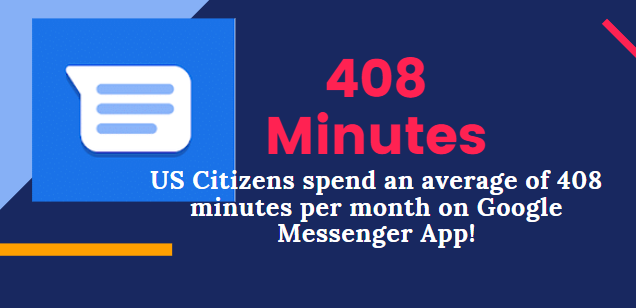
- The US citizens spend an average of 408 minutes a month on Google messenger. It is the top mobile messenger app in the USA. (99firms)
- Snapchat gets half the attention as compared to Google messenger, and people spend 203 minutes per month on this app. (99firms)
- People spend 177.67 minutes per month on WhatsApp. (99firms)
- On Facebook messenger, people spend 94.67 minutes a month. (99firms)
Sessions of each app in use:
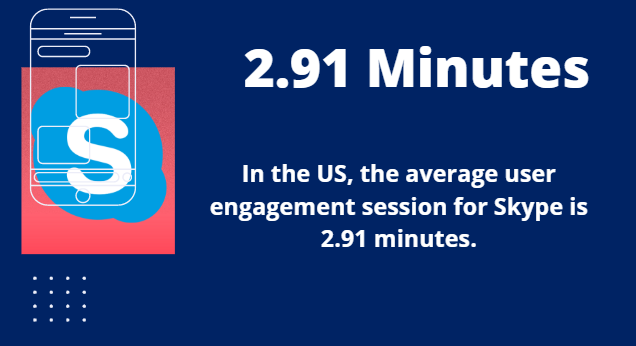
Considering the average user engagement session, Skype score over the rest. Features on Skype are much better than the peers in this segment, as it offers live sessions allowing users to see each other while talking. Now a day, many companies prefer to live interviews, and Skypes services are better in terms of quality. Also, it is the best app for live online coaching. (99firms)
- In the US, the average user engagement session for Skype is 2.91 minutes. (99firms)
- In Google Hangout, the average user engagement session is 2.43 minutes. (99firms)
- Viber shows 2.02 minutes as an average user engagement session. (99firms)
- The average user engagement time on WeChat is 1.9 minutes. (99firms)
- With Snapchat, the average user engagement session is 1.79 minutes. (99firms)
- The average user engagement session on WhatsApp is 1.69 minutes. (99firms)
Reach of service provider among users:
When you continue using an app, you will get more exposed to it and its features. Generally, there will be frequent updates, introducing new added features and emoticons. Mobile messaging apps offer features to add multiple people in the same conversation. Messaging to a group of people is more fun. People who use these apps generally influence their others to use these services, which makes communication quick and easy. But in the case of SMS, you will have minimal options and no group chat features.
The reach of mobile messenger app services for the year 2019 is as follows:
- Facebook messenger was able to reach out to 57.2%. (99firms)
- Snapchat reach out was 25.9%.(99firms)
- WhatsApp reaches out was 13%. (99firms)
Global leader:
WhatsApp is the global leader in the growing messenger market. As newer features have been adding, the usage of WhatsApp has become more accessible, and as a result, it attracts more users. Its presence in developing countries and third world countries is on the rise. The market of the smartphone in the third world and developing countries are witnessing rapid growth.
Since most of the smartphones come with pre-installed mobile messenger apps, people use online messaging apps for conversation rather than SMS. Many smartphones are selling in the market with pre-installed WhatsApp, which is an added feature. Also, WhatsApp works well on a slow speed internet signal, which is beneficial for users in poor internet connectivity.
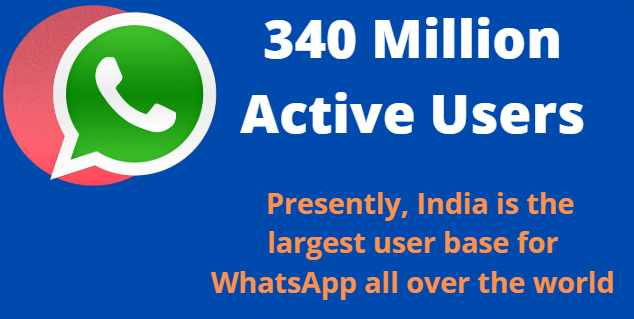
Top country-wise user statistics for WhatsApp:
- 340 million active users in India, the largest market presently. (99firms)
- 99 million active users in Brazil. (99firms)
- 1 million active users in the USA. (99firms)
- 9 million active users in Indonesia. (99firms)
- 2 million active users in Mexico. (99firms)
- 1 million active users in Russia. (99firms)
Age group:
If we look at the different sets of age groups, they have different preferences for messaging apps. All do not use the same app. The easier the app is to use; the more people will use it. Elderly and young prefer to use the apps which have less complicated features and can use faster. While the working class prefers apps with multiple features and where group chats are fun and quicker. The working user group wants larger groups at the office and home so that they can be in touch with friends and family all at once.
- 84% of British people between the age group of 25 – 35 years use WhatsApp. (99firms)
- Only 74% of the 35- 44-year-old British people use WhatsApp. You can see that as age increases, the preferences have changed. (99firms)
- In India, it has found that 55% of 18-34-year-old men prefer to use WhatsApp. (99firms)
- In the USA, age group 15-25 prefer to use Snapchat and the working class between 26-45 use WhatsApp, while those above 56 again prefer to use Snapchat. (99firms)
Gender basis:
There has been a gender bias in the use of the online messaging app, though nobody imposed it forcefully; still it is interesting. You can see more men are using mobile message apps than women. But this difference is slowly going to diminish. In the modern world, virtually no difference between men and women as everyone possess a smartphone. And all those who have a smartphone will sooner or later come online to use these services. While men like to use it for official purposes, women want to keep in touch with friends and family and keep the gossip circulating.
- In India, gender bias is evident and loud. 77% of males use online messaging services, whereas only 23% of women use such service. (Bizibl)
- In Singapore, the gap is a little lesser. Here 53% of males are using online messaging service while 47% of females are using, which is very close to male numbers. (Bizibl)
- In Spain the ratio is in the reverse swing; 52% of women and 48% of men use online messaging apps. (Bizibl)
- In the young generation group, the usage is high in Spain. 98% of teen girls in the age group 16-24 use online messaging service, and the statistics for boys of the same age group are 92%. (Bizibl)
- In France, the ratio looks very balanced; 54% of men and 59% of women use the online messaging service. (Bizibl)
In terms of revenue:
When we study the revenue pattern of mobile message apps, the revenue of WhatsApp shows a significant rise. The revenue figures reflect the growth of the online messaging app, and it continues to increase with each passing day.
- In the fourth quarter of the year 2018, Facebook reported $17 billion in revenue, and net income was $7 billion. When compared to the previous year, it was an increase of 30% and 61%, respectively.
- The total revenue of Facebook for the year 2017 was $14 billion, and for the year 2018, it was $56 billion.
- The mobile operators in the entire world are known to have made $ 9 billion for messaging in 2017.
Separate statistics of WhatsApp is not available since the acquisition by Facebook. However, the following are the prediction by Forbes.
- WhatsApp expected to make $4 per user, and it projected the user base for the year 2020 to cross 1.3 billion, which evidently can generate $5billion. (Digitalinformationworld)
- WhatsApp was able to collect $15 billion in the mid of 2017 from a user base of 1.3 billion, and it could generate a revenue @ $12 per user. (Digitalinformationworld)
Top Social Messengers in the World (Hootsuite)
Conclusion:
As we have seen from the above data, the entire world is under the influence of various mobile message apps, more and more users are coming onboard the online messaging service. These numbers are bound to increase further as the speed of the internet is becoming faster and faster with each passing year.
Who leads the market? The data is very clear about it. The undisputable leadership goes to WhatsApp, followed by Facebook, and both are from the same family. The advancement of internet technology will reduce the cost of operation, which will help the service providers economical services with cutting edge features. Hence in the coming years, online messaging is going to be even more popular, and people will be using it for commercial as well as personal activities.
Reference link:
https://www.statista.com/statistics/258749/most-popular-global-mobile-messenger-apps/
https://www.statista.com/statistics/483255/number-of-mobile-messaging-users-worldwide/
https://kommandotech.com/statistics/messaging-apps-statistics/
https://99firms.com/blog/most-popular-messaging-apps/#gref
https://www.digitalinformationworld.com/2019/02/whatsapp-facts-stats.html
https://www.businessofapps.com/data/whatsapp-statistics/#3
https://blog.hootsuite.com/11-people-join-social-every-second/
Explore Related reccomendations
TikTok Statistics, Usage And Facts (2020 Report)
- According to 0 users
Telegram Revenue and Usage Statistics 2020 report
- According to 0 users
Apps Statistics, Usage & Downloads (2020 report)
- According to 0 users
Mobile Vs Desktop Internet Usage Statistics 2021
- According to 0 users


